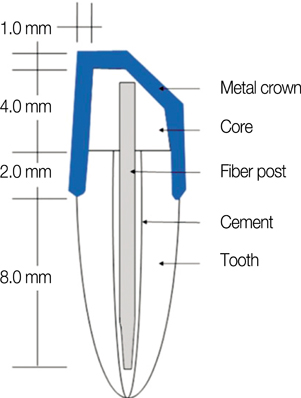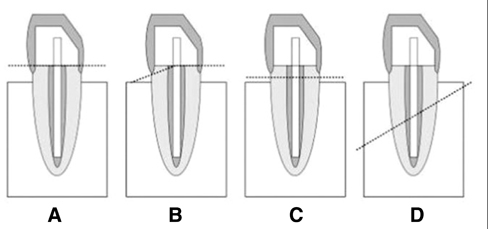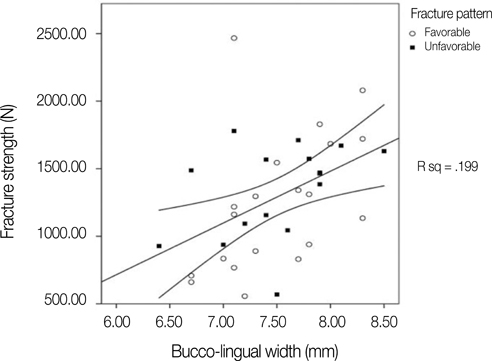J Adv Prosthodont.
2012 Feb;4(1):37-42. 10.4047/jap.2012.4.1.37.
Influence of modification in core building procedure on fracture strength and failure patterns of premolars restored with fiber post and composite core
- Affiliations
-
- 1Department of Prosthodontics, College of Dentistry, Dankook University, Cheonan, Korea. huk928@chol.com
- KMID: 2284782
- DOI: http://doi.org/10.4047/jap.2012.4.1.37
Abstract
- PURPOSE
The influence of the modified process in the fiber-reinforced post and resin core foundation treatment on the fracture resistance and failure pattern of premolar was tested in this study.
MATERIALS AND METHODS
Thirty-six human mandibular premolars were divided into 4 groups (n = 9). In group DCT, the quartz fibre post (D.T. Light-post) was cemented with resin cement (DUO-LINK) and a core foundation was formed with composite resin (LIGHT-CORE). In group DMO and DMT, resin cement (DUO-LINK) was used for post (D.T. Light-post) cementation and core foundation; in group DMO, these procedures were performed simultaneously in one step, while DMT group was accomplished in separated two steps. In group LCT, the glass fiber post (LuxaPost) cementation and core foundation was accomplished with composite resin (LuxaCore-Dual) in separated procedures. Tooth were prepared with 2 mm ferrule and restored with nickel-chromium crowns. A static loading test was carried out and loads were applied to the buccal surface of the buccal cusp at a 45 degree inclination to the long axis of the tooth until failure occurred. The data were analyzed with MANOVA (alpha = .05). The failure pattern was observed and classified as either favorable (allowing repair) or unfavorable (not allowing repair).
RESULTS
The mean fracture strength was highest in group DCT followed in descending order by groups DMO, DMT, and LCT. However, there were no significant differences in fracture strength between the groups. A higher prevalence of favorable fractures was detected in group DMT but there were no significant differences between the groups.
CONCLUSION
The change of post or core foundation method does not appear to influence the fracture strength and failure patterns.
Keyword
MeSH Terms
Figure
Reference
-
1. Terry DA, Triolo PT Jr, Swift EJ Jr. Fabrication of direct fiber-reinforced posts: a structure design concept. J Esthet Restor Dent. 2001. 13:228–240.2. Stewardson DA. Non-metal post systems. Dent Update. 2001. 28:326–336.3. Freedman GA. Esthetic post-and-core treatment. Dent Clin North Am. 2001. 45:103–104.4. Maccari PC, Cosme DC, Oshima HM, Burnett LH Jr, Shinkai RS. Fracture strength of endodontically treated teeth with flared root canals and restored with different post systems. J Esthet Restor Dent. 2007. 19:30–36.5. Akkayan B, Gulmez T. Resistance to fracture of endodontically treated teeth restored with different post systems. J Prosthet Dent. 2002. 87:431–437.6. Medina Tirado JI, Nagy WW, Dhuru VB, Ziebert AJ. The effect of thermocycling on the fracture toughness and hardness of core buildup materials. J Prosthet Dent. 2001. 86:474–480.7. Cho GC, Kaneko LM, Donovan TE, White SN. Diametral and compressive strength of dental core materials. J Prosthet Dent. 1999. 82:272–276.8. Combe EC, Shaglouf AMS, Watts DC, Wilson NHF. Mechanical properties of direct resin core build-up materials. Dent Mater. 1999. 15:158–165.9. Levartovsky S, Goldstein GR, Georgescu M. Shear bond strength of several new core materials. J Prosthet Dent. 1996. 75:154–158.10. Yaman P, Thorsteinsson TS. Effect of core materials on the stress distribution of posts. J Prosthet Dent. 1992. 68:416–420.11. Oliva RA, Lowe JA. Dimensional stability of composite used as a core material. J Prosthet Dent. 1986. 56:554–561.12. Eiriksson SO, Pereira PN, Swift EJ Jr, Heymann HO, Sigurdsson A. Effects of saliva contamination on resin-resin bond strength. Dent Mater. 2004. 20:37–44.13. Sorensen JA, Engelman MJ. Effect of post adaptation on fracture resistance of endodontically treated teeth. J Prosthet Dent. 1990. 64:419–424.14. Libman WJ, Nichollas JI. Load fatigue of teeth restored with cast posts and cores and completes crowns. Int J Prosthodont. 1995. 8:155–161.15. Ng CC, Dumbrigue HB, Al-Bayat MI, Griggs JA, Wakefield CW. Influence of remaining coronal tooth structure location on the fracture resistance of restored endodontically treated anterior teeth. J Prosthet Dent. 2006. 95:290–296.
- Full Text Links
- Actions
-
Cited
- CITED
-
- Close
- Share
- Similar articles
-
- Evaluation of static fracture resistances and patterns of pulpless tooth restored with poly-ether-ketone-ketone (PEKK) post
- A study for the bonding strength of composite resin core to glass fiber post
- Fracture resistance of upper central incisors restored with different posts and cores
- A STUDY ON THE FRACTURE STRENGTH OF TEETH RESTORED WITH A CARBON FIBER POST UNDER CYCLIC LOADING
- The fracture characteristics of glass fiber post and core on using different types of core resin materials





